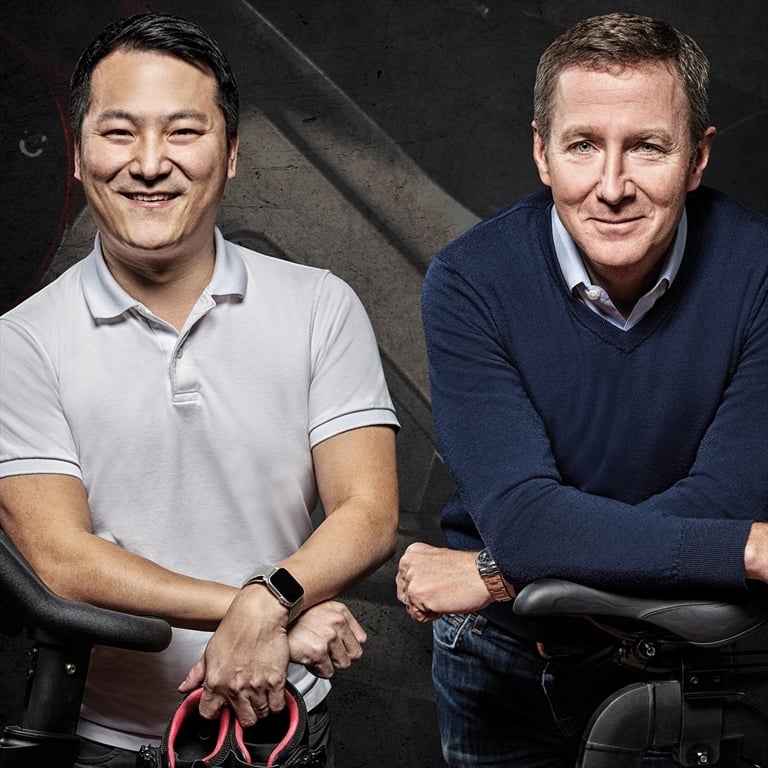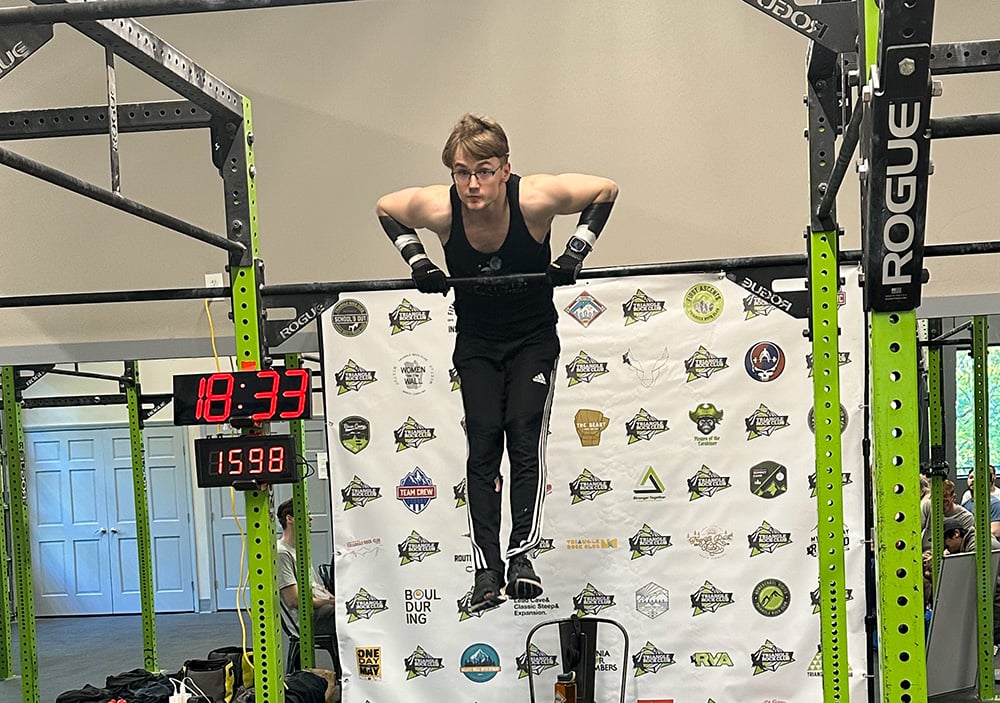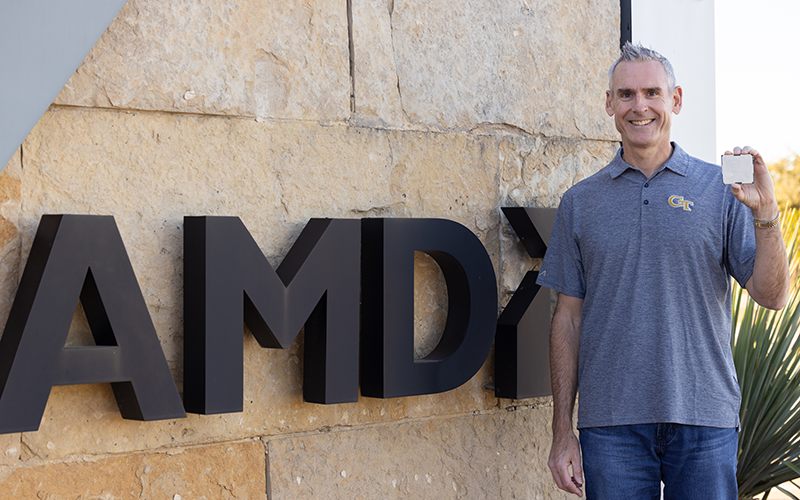Let It Ride
By: Kelley Freund | Categories: Alumni Achievements

Except it did. Seven years later, Peloton—with internet-connected, indoor exercise bikes and treadmills, live and on-demand classes, taught by world-class instructors—has brought the energy and social motivation of studio-style workouts into homes across the country. Hugh Jackman is a fan. So is Richard Branson, Jimmy Fallon and Kate Hudson. And so are more than 1.6 million other community members worldwide.
As Peloton continues to roll out new technologies and expand to new markets around the globe, Foley and Feng believe their company is poised to be one of the most influential consumer brands of the next decade. They’re banking that 10 years from now, many of us will be saying, “Remember when we had to leave the house to go to a gym class?”
THE EUREKA MOMENT
Long before John Foley, IE 94, became CEO of Peloton—before he headed up e-commerce operations for Barnes & Noble and was at the helm of Evite and Pronto.com—there was a time, growing up in Key Largo, Fla., when he thought he might want to be a pilot. So his father, who worked for Delta Airlines, would take him flying over the Florida Keys. But it turned out Foley was much more interested in looking for fishing holes than learning to fly the plane.
And in high school when his SAT results arrived, revealing a 220-point difference between his math and reading scores, he knew he wouldn’t be studying history or English. So he headed towards Georgia Tech—named a “Best School for Your Money” in a copy of U.S. News and World Report that his dad brought home—and a career in industrial engineering.
As a student, Foley participated in Tech’s co-op program, which meant he attended classes in the winter and summer quarters and then worked as an engineer at the M&M/Mars manufacturing plant in Waco, Texas, in the spring and fall. He returned to the plant after graduating, landing a plum job and working there for six years as a production shift manager before moving on to a career exploring the burgeoning world of the internet.
During his stint at Barnes & Noble, Foley saw the Nook reading device help disrupt a massive category of book retailing: With so many people consuming content through this new platform, the four-wall bookstore was becoming a dinosaur. Then one day in 2011, Foley was taking an indoor cycling class—one he barely had time for since the birth of his second child—and he thought to himself: “Here’s another four-wall location. Why can’t this be digitized, too?”
The local gym could also go the way of the dinosaur.
Putting a cycling class online, after all, would have many advantages to fitness consumers. People wouldn’t have to pay $30 every time they stepped into a boutique studio. It would also allow new parents or time-pressed professionals to take a class whenever they wanted. And it even had the possibility of improving the exercise experience.
From his bike in class that day, Foley had to strain his neck around a pole to see the instructor. But he realized by positioning cameras around a studio and streaming the class to a consumer’s home, every viewer would have a front-row seat.
Foley had spent the past 15 years in the consumer internet world, surrounded by websites, web apps and pure software. But spending all those years at the M&M/Mars manufacturing plant was about to pay off.
“As I started to think about creating this new company, I found I wasn’t afraid of the hardware aspect,” Foley says. “I wasn’t afraid to create physical things, an earthly product.”
The only problem? He didn’t know how to build that product.
“That’s when I needed Yony,” he says.
HARDWARE AND SOFTWARE
After immigrating to the United States from China when he was 8 years old and settling in Duluth, Ga., Yony Feng, CmpE 06, MS ECE 07, found himself taking a number of art classes in middle school and high school—and realized art was not something he should pursue any further. His father was a scientist who conducted research in the medical field, and Feng thought he might want to do something similar.
However, the theoretical portion of science proved to be tougher than he thought. So he decided to study something far more practical at Georgia Tech—electrical and computer engineering.
Feng says he often felt like he was drinking through a fire hose while he was a student at Tech, as he took classes for his undergraduate and master’s degree at the same time, but the Institute prepared him for what he thought he might want to pursue down the road: working for an early-stage startup.
“The entire Georgia Tech experience is akin to creating a startup,” says Feng. “You have to be resourceful and have grit. Nothing is handed to you for free and when you look back, you’re always amazed at how far you can be pushed.”
But Peloton was still a few years away. After graduating, Feng moved to Silicon Valley to work at Cisco on B2B software before he moved on to consumer-focused software—the text-chat platform at Skype. For Feng, from a skill-set perspective, these jobs were indispensable. “It’s important to get a few years’ experience of applying what you learned in school and seeing how the juice is made before you’re running a manufacturing plant with the juice,” Feng says.
When Feng’s college roommate, who also knew Foley, told him about the Peloton idea, Feng was in a U-Haul truck driving to a new job at Ticketfly in San Francisco. He was pretty sure he wanted to come aboard at Peloton and wondered if he should even bother unpacking.
Foley and Feng officially launched the company in February 2012 with three other business partners. A Schwinn stationary bike with a computer monitor rigged to the front was used as an early prototype, and Feng set out to prove he could get the Android app he created to talk to the hardware. Next, the team curtained off a section of the office for a “studio,” and began streaming their classes to a bike on the other side of the office; they then live streamed to someone’s living room. By August 2012, they had a prototype ready to show off to investors.
But getting people interested in hardware proved to be, well, hard. Venture capitalists are not always interested in investing in companies with physical components, as those components can be expensive and complex to produce. Foley remembers pitching the product three times a day for four years, with 400 investors turning him down. At the time, he was cleaning the Peloton office bathrooms himself because the company couldn’t afford to hire an office support staff and pay their engineers.
Peloton turned to the internet and crowdsourcing for help. The company launched a Kickstarter campaign in 2013, promising everything from water bottles to reserved usernames and a year of free classes. The company raised more than $300,000 through Kickstarter, and eventually traditional VC funding followed. By 2014, Peloton had its first bikes on the market.
IN THE SADDLE
Peloton instructor Robin Arzon starts the cycling class by telling participants to bring the good vibes. “You don’t know me and you don’t know my style,” she sings as she dances on her bike. Then she gets serious and places her hands on the handles. She commands the class: “Turn up that cadence. I’m not holding back today!”
Arzon and her workout are exactly what you would expect if you were to take a class at a high-end gym or workout studio. But you’re at neither of these. You’re in your basement. Or living room. Or guest room. Wherever it’s most convenient. And you’re streaming Arzon’s workout through a Peloton bike which displays the action live on a high-tech screen inches from your face. Truly, you have a first-row seat, just as Foley imagined.
Every month, Peloton features up to 950 live classes taught by instructors like Arzon, shot in three studios—two in New York and one in London. In case you can’t make it to your bike for a live class, Peloton also offers thousands of on-demand ones that members can stream at any time. And if cycling isn’t your thing, Peloton offers a mix of other workouts, from running (with the company’s new treadmill) to strength training to yoga and meditation (which you can stream with just the company’s app, no equipment required).
This content—the instructor’s motivation, the music, the workout itself—is just part of what Peloton brings to your home. Through social software created by Feng and his engineering team, Peloton also makes you feel like you’re part of a community—and not working out alone in your basement.
When members take a live class, their Peloton screens display a leaderboard, which participants can filter according to age group and gender. Also shown are location and statistics, such as output, a combined metric of a rider’s total cadence and resistance. If you see someone from your hometown is dragging during an uphill climb, you can send them a virtual high-five. And if you're taking an on-demand class, there is a “here now” leaderboard so you can see how you rank against everyone else riding at the same time as you, whether live or on demand.
Instructors have their own software that displays details like how many workouts a participant has completed, and they use that information to interact with people working out at home. As Foley puts it, the teachers can break the “fourth wall” to congratulate you on your 100th ride. These interactions create an immersive, communal experience that can make you feel like you’re actually in a cycling class at the gym, without all of the inconveniences. “All of that is very easy to say,” Foley says. “I still don’t know how Yony built it.”
As CTO and CIO, Feng oversees a team which ensures that Peloton’s streaming works for a large number of riders across the world and that all the leaderboard data is distributed successfully. That data comes from a console attached to each internet-connected bike. The console runs a customized operating system that gathers metrics from the bike, then aggregates the data and sends it to a cloud platform. Imagine all the data that had to be processed on Thanksgiving Day in 2018, when 19,700 people took a live “Turkey Burn” class, setting a world record for the largest ever live cycling class.
Feng and his team push code daily to any one of the company’s platforms, and components continue to be tweaked and improved as the company invests in software and hardware engineers and new consumer-facing features. (Recently, Peloton announced controls that allow riders to independently adjust the volume of the instructor’s voice and the background music.)
As of this fall, Peloton claimed it had more than 1.6 million members and had sold 577,000 of its connected fitness products. The company went public with an IPO on Sept. 26, 2019 and suffered a few first rocky months on Wall Street. But the results didn’t seem to faze the company’s founders regarding Peloton’s future. “We’re playing the long ball,” Foley said during an interview at Vanity Fair’s New Establishment Summit in October. “We’re playing for the next decade of building one of the special consumer brands.”
The $1.2 billion raised from the IPO will allow for even more innovations from the company and for Peloton to be rolled out to more markets, Foley says. The company is investing money in another New York City studio, which Foley believes will be the best digital television streaming studio in the world.
By April 2020, Peloton plans to have retail stores in six major cities across Germany, and they will be hiring instructors to teach classes in German, which will be produced in the company’s London studio. With plans to eventually have studios around the globe, each producing at least 10 classes a day, Peloton seems poised to take over the home fitness world.
HEAVY RESISTANCE
Back in 2012, Peloton was so small they couldn’t even get people to call them back regarding music rights. (The company would go on to create a new category of music licensing rights and eventually purchase its own music technology platform, Neurotic Media, based in Atlanta.) Raising money has always been a challenge. And for the past eight years, it’s been hard to get people to believe in the future of Peloton, including, Foley points out, right now.
“Fitness continues to have a lot of naysayers,” he says. “It’s been a hard category for decades with bad models, bad products, bad marketing and bad fads.”
Feng says he underestimated how hard it would be to reverse those stereotypes. “There has been a lot of brand damage to the fitness industry over the years,” he says. “It's a constant challenge to change the image of fitness and shine a positive technology innovation angle to this industry. It continues to be a message that we have to consciously reinforce regularly.”
That negative image is something that has impacted Peloton’s ability to recruit talent from day one. And another recruiting challenge stems from Peloton’s diverse technology needs, which include not just software engineers, but mechanical, industrial and electrical engineers.
“We’re in a lot more disciplines than your average tech company,” Feng says. “It’s challenging to create a company from the ground up with such a wide and diverse need for engineering talent. You really have to navigate through what types of talent you can attract, as well as the strengths and weaknesses of your team, to be able to achieve that member experience.”
Some articles and reviews of Peloton criticize the high price tag that comes with that member experience. Peloton’s bike is priced at $2,245, while you can expect to hand over $4,295 for the treadmill, plus a $39-per-month subscription for streaming content. The company’s ads feature Peloton products in high-end homes, suggesting that it’s a luxury brand geared to well-to-do consumers.
But Foley says the idea that Peloton is for rich people is flat out wrong. In the company’s beginnings, Foley worked in the retail stores (and occasionally still does on weekends) and says he personally has sold hundreds of bikes to teachers. Close to 20 percent of bikes sold last year went to households making less than $75,000 in combined income, Peloton claims.
In an effort to democratize fitness, the company offers financing plans (you can buy the bike for $58 a month), as well as digital-only subscription packages for strength, yoga, cardio stretching and meditation classes for $12.99. (The company claims nearly 106,000 subscriptions.)
Some copycat outfits have popped up, marketing themselves as cheaper alternatives to Peloton. Echelon Fitness hit the market in 2018 with a similar product—so similar in fact that at a quick glance, the companies’ logos look the same. In October 2019, Peloton filed a lawsuit against Echelon, accusing them of infringing on patents and trademarks. The suit was not a first for the company.
In September 2018 Peloton sued Flywheel, claiming the company also copied its technology. (The lawsuit is ongoing, but Flywheel is in the process of shutting down more than a quarter of its cycling locations.)
Other similar products are on the way. In August, Equinox, the parent company of SoulCycle, announced plans for its own streaming indoor cycling and treadmill classes.
Still, Foley and Feng like Peloton’s chances, pointing out that the company has an almost 8-year head start and, now, a substantial balance sheet. And the company is incredibly dedicated to its subscribers. In the fall, Foley ventured out on a 15-city tour, having dinner with members to hear about their Peloton experiences and the software features and content they want more of.
“Serving our members is our true north,” says Feng. “And we have an incredible team that is working together to achieve that. That’s the formula for staying ahead and being a market leader.”
A FIERCELY LOYAL FOLLOWING
This past fall, 3,000 riders from 49 states descended on New York City for Peloton Homecoming, an annual convention of the company’s biggest fans. The concept for the event was born a few years ago when it was brought to the company’s attention that groups of people who had befriended each other through Peloton were coming together to meet in person, spend a weekend in the city and take a class at the studio. This migration was originally known as a Home Rider Invasion, and it was something that Peloton founders could not have predicted when they created the company.
But now, various Facebook and Instagram communities have popped up, from Pelo-Foodies to Scuba Lovers of Peloton to Pelowinos. Except for the brand’s official Facebook page, which has more than 200,000 members, and the Official Peloton Mom Group, these groups are run by members, with no involvement from Peloton.
But the mingling doesn’t stop there. There has been at least one Peloton marriage—a couple who met on a Peloton message board.
Tickets for the 2019 Peloton Homecoming sold out in 10 minutes, and fans braved long lines and rain to snap a photo with their favorite instructors. Some of the Peloton instructors have reached celebrity status, with hundreds of thousands of people following their social media feeds, and at this point, the job is a coveted position. In a recent search for new yoga instructors, the company interviewed 425 yogis across the country for three open positions.
Perhaps most representative of the company’s loyal following are those who showed up to the Homecoming event brandishing Peloton tattoos. Certainly when Foley and Feng helped found the company in 2012, they didn’t think they would find their company’s logo permanently inked on their customer’s bodies. But perhaps it’s not so surprising in retrospect.
“People love their fitness programs,” says Foley. “And they love good, thoughtful brands.”
Both Foley and Feng are Peloton consumers. Foley uses his bike a few times a week. Feng is a new father and finds that holding a six-month-old has taken a toll on his back and posture, so many mornings before work, he completes a 10-minute Peloton strength or stretching class while his daughter hangs out nearby.
“At the end of the day, we’re working towards a vision that is benefiting the health of people all over the world,” Feng says. “I like seeing the impact Peloton has on people. That motivates me every day.”
That’s good, because there’s so much more Foley and Feng want Peloton to accomplish.
Five years ago, Foley points out there were just hundreds of people who loved Peloton. Today that number is 1.6 million, but he says that still feels small. He can’t wait to get Peloton into the homes of tens of millions of people around the world.
“At our core, we our entrepreneurs—innovation and creation are in our blood,” says Foley. “We see Peloton as a several hundred-billion-dollar global tech platform and one of the most influential consumer brands in the next decade. We do not feel like we’re a big deal yet—we feel like those days are still ahead of us. We’re very hungry to come into work and someday realize all our dreams for the company and its impact.”


